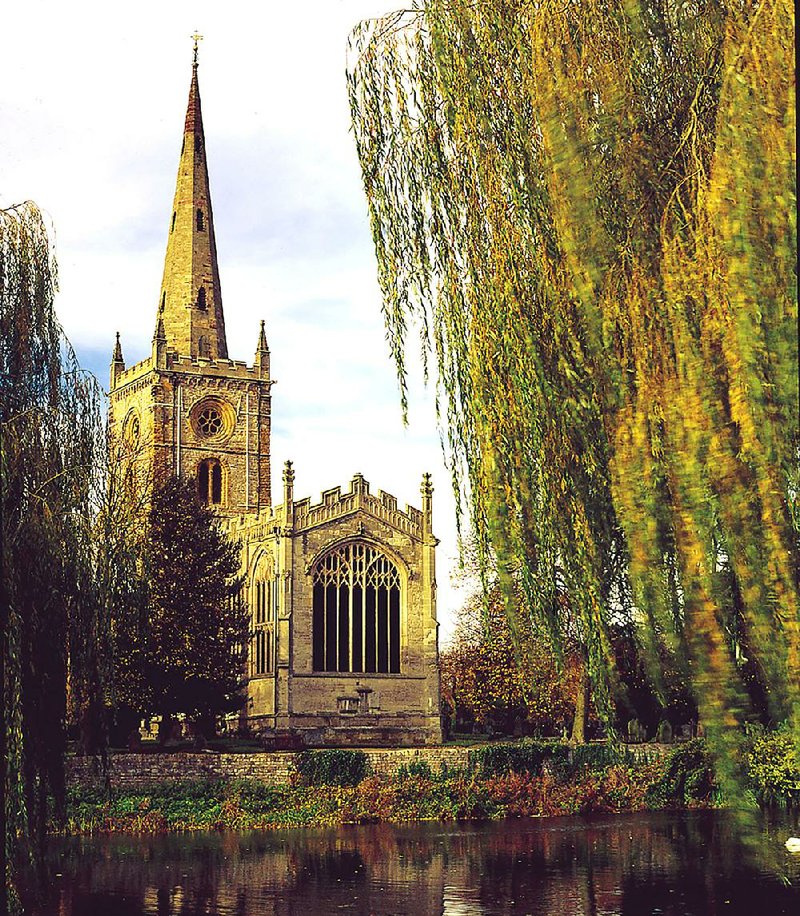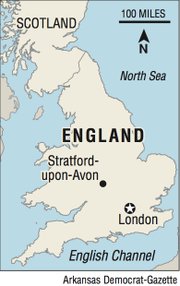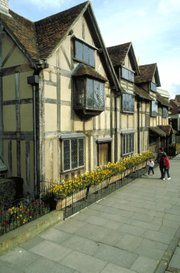STRATFORD-UPON-AVON, England - Many people say that April 23, 2014, will be William Shakespeare’s 450th birthday. I believe it.
When it comes to Shakespeare, I believe it all.
Of course, there are those who deny that the son of a Stratford glover could have written the greatest plays in the English language. But none of that has ever dimmed for me the glory of Shakespeare’s plays or the glow of my first Shakespeare trip.
For my first pilgrimage to Britain, I shot north from London to Stratford-upon-Avon to worship along the well-trod Bardic Route.
It would be all Shakespeare all the time, following in his first toddler steps in the family kitchen through his burial in the village church. In between, like millions of English students before me and millions yet to come, I wanted to see - don’t touch! - his boyhood school, his wife’s family home and the spot where the great writer retired in this Warwickshire market town.
This year, more pilgrims than ever are heading for the West Midlands, to celebrate Shakespeare’s 450th birthday. After London, Shakespeare Country is the most popular destination in England, and the Bardic industry in Stratford is geared up for the pilgrim onslaught.
Most pilgrims, of course, start at Shakespeare’s Birthplace, a half-timbered building that was the biggest house on Henley Street when John Shakespeare bought it in 1556. He and his wife, Mary, welcomed their first son, William, here in late April 1564.
Since the baby’s baptism was recorded in Holy Trinity Church on April 26, revisionists couldn’t resist backdating his birth to April 23, the English holiday of St. George’s Day.
At his birthplace, which is actually two houses fitted together, it’s good to start loading up on the pinches of salt all Shakespeare fans need when they tour Stratford. Some details of his long-ago life were never recorded; others are lost to time. I know now that some of what I “learned” on my first Shakespeare haj was wishful thinking by enthusiastic locals. Nevertheless, pilgrims who sign on for the full, joyful experience can connect the dots from site to site with zeal and satisfaction.
How darling, for instance, is the little wooden ring wrapped around a kitchen post, the “babyminder” that kept little Will safely away from the blazing hearth?
And how surprising are the signatures etched into the windowpanes of an upstairs room, with Sir Walter Scott, Thomas Carlyle and dozens of others leaving their marks? The writers were so inspired by “The Sweet Swan of Avon,” as Ben Jonson called Shakespeare, that they felt impelled to scratch their names into the eternal fabric of the building.
Chronologically, then, the route wends to the King Edward VI School, where Shakespeare studied. His father’s role as mayor of Stratford helped the lad gain admission.
Then it’s over the bridge and across the meadow to Shottery, where an 18-year-old Will courted Anne Hathaway in her family’s picturesque, thatched home.
The Hathaways were yeoman farmers, whose descendants lived in the long, low house until 1892. That’s nirvana to preservationists, because the building was never modernized.
The romantics among us swoon at the straight-backed wooden settle (bench) where Will and Anne supposedly courted by the fire. We admire every scratch. The couple must have moved beyond the hearth, though, because Anne was pregnant with Susanna when they married in 1582.
The young family lived with Shakespeare’s family on Henley Street for five years. Shakespeare moved to London about 1585-1590, according to scholars who tracked his rise on the London literary scene.
Shakespeare’s triumphs are chronicled in Stratford at his namesake center at the birthplace and on the stages of the Royal Shakespeare Theatre, The Other Place and The Swan. Like the Globe in London, The Swan is a replica Elizabethan “wooden-O” stage, which helps set the plays in their physical context and bridge the 400 years between playwright and audience today.
Shakespeare returned to Stratford-upon-Avon often, and in 1597 bought New Place, the second-largest house in town. He stayed there when he wasn’t working in London, and some scholars think he wrote The Tempest at home in Stratford.
Legend says Shakespeare planted a mulberry tree in the lawn, and it was this tree that drove a later New Place owner, the Rev. Francis Gastrell, to frenzy. A never-ending parade of pilgrims arrived on his doorstep, trampling the grounds and stealing bits of bark.
First, he chopped down the mulberry in 1756. And yet the crowds came. To the Rev. Gastrell, there was nothing for it but to pull New Place down in 1759.
Tragically, there’s nothing left but a beautiful knot garden with, we romantics like to think, an offshoot of Shakespeare’s own mulberry tree. The Shakespeare Birthplace Trust is planning a ghostlike structure on the footprint of New Place, much as Philadelphia has re-created the 3-D outline of Benjamin Franklin’s lost home. Plans are for completion by 2016, the 400th anniversary of Shakespeare’s death.
Some of Shakespeare’s family homes, however, do survive, such as Nash’s House, the gateway to the foundations of New Place. Shakespeare’s granddaughter and last direct descendant, Elizabeth Hall, lived here with her first husband, Thomas Nash.
Nearby, Hall’s Croft is an elegant Jacobean home where Shakespeare’s eldest daughter, Susanna, and her doctor husband, John Hall, lived. There’s much to admire in the fine rooms and walled garden, and much to fear in the display on Elizabethan medicine.
Many visitors prefer the back view of the house, wandering through medicinal herbs that John Hall might have used in his practice and hollyhocks that Susanna might have planted for their good cheer.
To wrap up the family homes, there’s always the farmstead of Mary Arden, Shakespeare’s mother. When I first drove the three miles north to Wilmcote, all Arden signs pointed to the prosperous timber-framed homestead with a stone dovecote and extensive outbuildings, chocolate-box perfect.
Since then, a local historian has proved that Arden’s childhood home really was the plain brick house at Glebe Farm next door. And this was no simple misunderstanding. Tour guide John Jordan decided the timber-framed house made a better story, and started spinning the tale to tourists in the 18th century.
But it’s all sorted now, and people tour Mary’s childhood home, then pop into the timber-framed Palmer’s Farm to try their hands at making bread and tending heritage animals, Tudor-style.
Scholars make careers unraveling the mysteries of Shakespeare. Two Shakespeare facts beyond dispute are his baptism in April 1564 and death in April 1616 - again, his death has been placed on April 23 for the symmetry with St. George’s Day. Copies of the pertinent register pages are on view at Holy Trinity Church, a Gothic landmark near the River Avon.
Because Shakespeare became a lay rector in the church in 1605, he was accorded the honor of burial in the chancel. He lies beneath a memorial and bust commissioned by his family a few years after his death and so, historians feel, a good likeness of the man.
Below the effigy lies, as Jonson said, “The Soul of the Age!” Pilgrims thrill to read the last line of one of the world’s most famous epitaphs: “And cursed be he who moves my bones.”
Travel, Pages 50 on 04/20/2014


